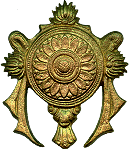
 OBJECTION: The gaudiya followers of Caitanya claim to be in the disciplic succession descending from Madhvacarya, yet we find certain anomalies which seem to prove otherwise. In light of these points, how can they claim that they are in the line of Madhvacarya, when they have differed from him philosophically and their lineage is so dubious?
OBJECTION: The gaudiya followers of Caitanya claim to be in the disciplic succession descending from Madhvacarya, yet we find certain anomalies which seem to prove otherwise. In light of these points, how can they claim that they are in the line of Madhvacarya, when they have differed from him philosophically and their lineage is so dubious?
Sri Madhvacarya taught the system of Dvaita Vedanta, yet the gaudiyas do not accept this philosophy. Rather they follow the system of Acintyabheda-bhedavada. If they are true followers of Madhva, what was the need of their Baladeva Vidyabhusana to write a separate commentary on Vedanta-sutras when Sri Madhva had already composed an exhaustive explanation?
REFUTATION: To say that the gaudiya vaisnavas do not accept the philosophy of Sri Madhva is not entirely correct. In his Prameya Ratnavali, the Gaudiya Vedantacarya Srila Baladeva Vidyabhusana, paraphrasing Sri Vyasa Tirtha, (1) has written nine points of Madhva that the gaudiya vaisnavas accept —
sri madhva praha
visnu paratatvamakhilamnayavedhyanca visvam
satyam bedhamca jivan hari-caranajusastaratamyan ca tesam
moksam visnvanghrilabham tadamalabhajanam tasya hetum pramanam
pratyaksaditraya cetyupadisati hari krsna caitanya candrah
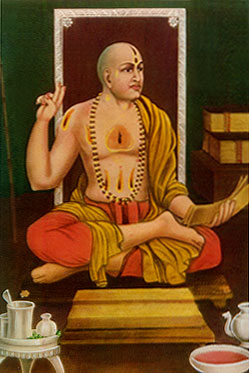 "Sri Madhva has said —
"Sri Madhva has said —
- Visnu is Supreme.
- He is known by the study of the Vedas.
- The Material world is real.
- The jivas are different from the Lord.
- The jivas are by nature subservient to the Lord.
- In both the conditioned and liberated condition, the jivas are situated in higher and lower statuses.
- Liberation is the attainment of Lord Visnu’s lotus-feet.
- Pure devotion grants liberation.
- Direct perception, logic and Vedic authority are the three sources of actual knowledge.
These truths are also taught by the Supreme Lord Himself in His appearance as Krsna Caitanyacandra."
However, one important aspect has not been elaborated upon and that is the aspect of rasa (divine loving mellows). This is explained by Srila Bhaktivinoda Thakura in verse 8 of his Dasamula Niryasa —
yada bhramam bhramam harirasagalad-vaisnavajanam
kadacit sampasyamstadanugamane syadruciyutah
tada krsna vrttya tyajati sanakairmayaikadasam
svarupam vibhrano vimalarasabhogam sa kurute
"After repeatedly wandering in the path of mayik existence, a fallen soul may meet a pure Vaisnava from whom trickles the nectar of the mellows of pure devotion to Lord Hari. By following that pure devotee, he becomes attracted to imbibe the sweet principle of devotional service. By constant study of Krsna-bhakti, he slowly abandons the mayik condition, and in the end obtaining his true nature, he enjoys the sweetest unalloyed rasa, which is the ultimate status of the soul."
It is to be understood that there is a progression in the descent of divine knowledge. Sri Madhva preached the philosophy of Dvaitavada in order to counter the widespread Mayavada doctrine of Adi Sankara which was prevalent at that time.
It is acknowledged by the gaudiya school that the doctrine of Dvaita is an intrinsic part in the evolution of theism. It was propagated according to kala and patra (time and circumstance) and was not meant to be the last word in the Absolute Truth.
Rasa-tattva is a very subtle truth and could not have been taught during that period of India’s history. The necessity of the time demanded that a powerful acarya boldly expound the basic beliefs of the Vedic scriptures and burn the weeds of Advaitavada to the roots. It is only fitting that the incarnation of Bhima perform this task. It would not be appropriate for such a forceful personality to simultaneously explain the subtle divine mellows of madhurya-rasa. This would be inconsistent with his mission. The intricate concepts of rasa-vicara were later expounded by Sri Caitanyadeva and His followers.
Our Tattvavadi friends raise the question as to why Baladeva wrote a commentary on the Brahma-sutras when Sri Madhva-acarya had already done so. It is understood that Srimad Bhagavatam is the natural commentary on the Brahma-sutras. This is stated in Garuda Purana —
artho ’yam brahma-sutranam
bharatartha-vinirnayah
gayatri-bhasya-rupo ’sah
vedartha-paribrmhitah
grantho ’stadasa-sahasrah
srimad-bhagavatabhidhah
"The Srimad-Bhagavatam is the authorized explanation of Brahma-sutras, and it is a further explanation of Mahabharata. It is the expansion of the gayatri-mantra and the essence of all Vedic knowledge. This Srimad-Bhagavatam, containing eighteen thousand verses, is known as the explanation of all Vedic literature."
However, since Sankara commented upon the pristine teachings of Vyasa found in the Brahma-sutras, it was the duty of the Vaisnava acaryas such as Sri Ramanuja and Sri Madhva to counter his doctrine of illusion and present their own commentaries.
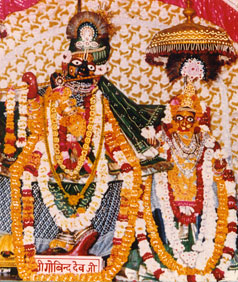
Sri Baladeva Vidyabhusana was challenged by the Ramanandi sect in Galta as to why the gaudiyas claimed to be affiliated to the Madhva sampradaya when they differed in philosophy to them. Again, this was a point of rasa-vicara because the gaudiyas worshiped the Deity of Govindadeva, regarding Him as superior to the form of Narayana. This is a point which will be discussed in a later chapter.
In order to prove the validity of the gaudiya sampradaya, Baladeva was told by the Ramanandis that it would be necessary for him to produce a commentary on the Vedanta-sutras supporting the gaudiya philosophy of Acintyabheda-bheda tattva. Baladeva did this in seven days and called his commentary the ‘Govinda Bhasya.’
His bhasya was so profound and complete that the opposition was silenced. Considering the fact that the Madhva sect have not explained the intricacies of rasa-tattva, it would have been futile for the gaudiyas to refer to Madhva-acarya’s commentary as their own.
Our Tattvavadi friends have referred to Madhva’s commentary on the Vedanta-sutras as ‘exhaustive’, inferring that there is nothing else to be said on the subject. We therefore raise the question, why did Jaya Tirtha write his Tattva Prakasika commentary to Madhva’s Vedanta-sutra-bhasya? Why did Raghavendra Tirtha write his Tattva Manjari commentary on the Anu-bhasya of Madhva? Why did Trivikrama need to write his Tattvapradipa commentary? In fact, all of the works of Madhva-acarya have been commented upon by many acaryas following in the Dvaita line.
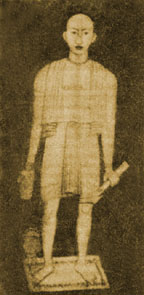
OBJECTION: You have explained that Baladeva Vidyabhusana accepted nine basic tenets of Sri Madhva-acarya, yet Sri Caitanya Himself only accepted one point and rejected the philosophy of Madhva. This seems to be a contradiction.
REFUTATION: In the Caitanya Caritamrta (Madhya 9.277) Sri Caitanya Mahaprabhu addressed the acarya of the Tattvavadis thus -
sabe, eka guna dekhi tomara sampradaye
satya-vigraha kari’ isvare karaha niscaye
"The only qualification that I see in your sampradaya is that you accept the form of the Lord as truth."
It is not that Sri Caitanya rejected Madhva’s philosophy (2), rather, he rejected the erroneous, distorted dogma which had entered the sampradaya of Madhva-acarya at that time. (3) This is the reason why Mahaprabhu used the phrase ‘tomara sampradaya’ (your sampradaya) rather than ’our sampradaya’ — in order to establish that He did not subscribe to the philosophy that was being propounded in the name of Madhva. Later, in the 16th Century, these inconsistencies were corrected to some extent by the great reformer Sri Vadiraja Tirtha. (4)
The major principle established by Sri Madhva-acarya was that the Lord and His creation are real and that the jiva is eternally subservient to Isvara - the nine prameyas enhance these points. In this way the gaudiyas strictly follow in the footsteps of Madhva-acarya.
OBJECTION: The gaudiyas accept Narada Rsi as the guru of Vyasa, whereas the followers of Madhva contest this since Vyasa Mahamuni needs no guru being a full incarnation of Godhead.
REFUTATION: This argument is foolish. Other incarnations of Godhead have accepted gurus — Sri Ramacandra accepted Vaisistha Muni as His preceptor and Sri Krsna accepted Acarya Sandipani. The acceptance of a spiritual guide by the Supreme Person is not a mundane activity. He does this to teach the importance of accepting a sat-guru to the minds of ordinary men. Therefore Sri Krsna tells Arjuna in Bhagavad-gita (3.23) -
yadi hy aham na varteyam
jatu karmany-atandritah
mama vartmanuvartante
manusyah partha sarvasah
"For if I ever failed to engage in carefully performing prescribed duties, O Partha, certainly all men would follow My path."
Furthermore Sri Krsna says in the Fourth Chapter of Gita, dharma-samsthapanarthaya, " I come to establish religious principles." By His acceptance of a spiritual preceptor, His Godhood is not affected. To suggest such a thing is simply atheism.
OBJECTION: Padmanabha Tirtha, Nrhari Tirtha, Madhava Tirtha and Aksobhya Tirtha are listed by the gaudiyas as having a guru-disciple relationship. However, it is an indisputable fact that these four personalities were all direct disciples of Sri Madhva himself.
REFUTATION: In his Prameya Ratnavali (v.7), Sri Baladeva Vidyabhusana writes —
sri krsna brahma devarsi, badarayana samjnakan
sri madhva sri padmanabha, sriman nrhari madhavan
aksobhya jaya-tirtha sri, jnanasindhu dayanidhi
sri vidyanidhi rajendra, jayadharma kramadvayam
purusottama brahmanya, vyasa-tirthams ca samstumah
tato laksmipatim sriman, madhavendran ca bhaktitah
tac-chisyan srisvaradvaita, nityanandan-jagat-gurun
devam-isvara-sisyam-sri, caitanyan ca bhajamahe
"Sri Krsna’s disciple was Brahma, whose disciple was the sage of the demigods, Narada. His disciple was Badarayana (Vyasa) whose disciple was Madhva. His disciple was Padmanabha, whose disciple was Nrhari. His disciple was Madhva whose disciple was Aksobhya, whose disciple was Jaya Tirtha. His disciple was Jnanasindhu, whose disciple was Dayanidhi. His disciple was Vidyanidhi whose disciple was Jayadharma. His disciple was Purusottama and his disciple was Brahmanya whose disciple was Vyasa Tirtha. His disciple was Laksmipati and his disciple was Madhavendra whose disciples were Isvara, Advaita and Nityananda the guru of the whole world. Another of his disciples was Sri Caitanya who we offer our respects to."
Similar verses are also found written by other gaudiya acaryas such as Sri Kavi Karnapura, Srila Visvanatha Cakravartipada, Narahari Cakravarti, Devaki Nandana and Srila Sarasvati Thakura.
It is a fact that Padmanabha, Nrhari, Madhava and Aksobhya were all contemporaries and direct disciples of Sri Madhva Muni. However, this does not rule out the fact that there was a siksa link between them, especially when one considers that Padmanabha was senior to Nrhari, Nrhari was senior to Madhava, and Madhava was senior to Aksobhya, who was the last initiated disciple of Madhva-acarya. This listing is given, since in the parampara of the gaudiyas, siksa is considered to be more important than diksa.
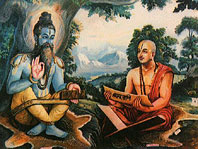 Although Madhva was given initiation by Acyuta Preksa, the gaudiya vaisnavas place more stress on the relationship between Madhva and Vyasadeva. This is because the siksa he acquired from Vyasa was of more importance from the transcendental perspective than that which he accepted from Acyuta Preksacarya.
Although Madhva was given initiation by Acyuta Preksa, the gaudiya vaisnavas place more stress on the relationship between Madhva and Vyasadeva. This is because the siksa he acquired from Vyasa was of more importance from the transcendental perspective than that which he accepted from Acyuta Preksacarya.
Therefore, the Madhva Parampara reads as follows:
Hamsavatara — Brahma — Catursana — Durvasa — Jnanasindhu Tirtha — Garudavahana Tirtha — Kaivalya Tirtha — Jnanisa Tirtha — Para Tirtha — Satya Prajna Tirtha - Prajna Tirtha — Acyuta Preksa — Madhva, etc.
Whereas the Parampara of the gaudiyas reads as:
Krsna — Brahma — Devarsi Narada — Vyasa — Madhva etc.
It is sometimes said that Padmanabha Tirtha was the diksa-guru of Nrhari Tirtha, but this is not supported anywhere. However, since Padmanabha Tirtha was senior to Nrhari, it would only be natural that he would impart important siksa to him. The same principle applies to Madhava Tirtha, Aksobhya Tirtha and all those acaryas after them, namely Jaya Tirtha, Jnanasindhu Tirtha, Dayanidhi Tirtha, Vidyanidhi Tirtha (Vidyadiraja), Rajendra Tirtha, Jayadharma Tirtha, Purusottama Tirtha, Brahmanya Tirtha, Vyasa Tirtha and Laksmipati Tirtha.
OBJECTION: There is mention of the names Jnanasindhu, Dayanidhi and Laksmipati Tirtha in the gaudiya Parampara, yet no one of that name is found in the Parampara lists of the Madhva sampradaya. We may therefore conclude that these personalities did not actually exist.
REFUTATION: The very fact that there is no mention of these names in any Madhva records does not negate the fact that such persons existed. It simply means that they never held a pontifical position in the Madhva sampradaya. Those renunciates of the Dvaita school who were never heads of any mathas are known as ‘bidi sannyasis’ (stray sannyasis) in the Kannada language. (5) Even Madhva scholars acknowledge that Vyasa Tirtha may have had a follower called Laksmipati. (6)
This argument does not stand, considering the lack of information you have on your own sampradaya-acaryas. You have scant information even about the direct disciples of Madhva-acarya, what to say of those who appeared after them? For example, every orthodox Madhva is familiar with the Mangalastakam and it is part of his nitya-kriya to recite it daily. However, it is still contested as to who composed it. Some say Sri Vadiraja Tirtha, others are in favor of Sripadaraja (Laksminarayana Tirtha). There is no precise information, only conjecture.
Just as our detractors deny the existence of a number of acaryas in our line, their logic can just as easily be used to argue that acaryas who pre-dated Madhva, such as Satya Prajna Tirtha, Prajna Tirtha, Durvasa etc. never existed and were simply the concoction of Narayana Panditacarya when he composed his ‘Mani Manjari’ in order to add historical and traditional credibility to his parampara. Similarly, it can also be questioned as to what transpired within the Madhva school after Prajna Tirtha, since it is admitted by them that there is a gap of over 400 years before the line starts again with Acyuta Preksa. (7)
OBJECTION: Since Madhavendra, the disciple of Laksmipati Tirtha, has the sannyasa title of ‘Puri’ (which is a dasanami title used by the Sankarites), how can you say he is coming in the line of Madhva?
REFUTATION: The title ‘Puri’ is indeed one of the ten sannyasa names used by the Sankara sampradaya, the others being Tirtha, Asrama, Sagara, Aranya, Vana, Giri, Parvata, Bharati, and Sarasvati.
It was in vogue with the members of the Madhva sect that sannyasis converted from the Sankara school were allowed to retain their titles rather than change them to ‘Tirtha’. This was done in order to demonstrate their victories over Mayavada. It could be deduced that Madhavendra Puri must have been either a direct convert or the disciple of such a convert.
Whichever way it may be, we gather from this that previously Sri Madhavendra had taken sannyasa in the line of Sankaracarya from a renunciate of the Puri order. However, as an acarya who taught the highest elements of Love of God, we must also accept that his diksa could only have been in a genuine disciplic lineage. His faith and love for Sri Krsna was far too sublime and deep to keep him within the bounds of the Madhva school itself, what to say of the illusory misconceptions of the sampradaya of Adi Sankara. (8)
Since it is mentioned by the gaudiya acaryas that Madhavendra’s guru was Laksmipati Tirtha, we conclude that his diksa was in the line of Acarya Madhva, though he may have accepted formal sannyasa in the line of Sankara. Mahaprabhu Himself took mantra-diksa from Isvara Puri (Madhavendra’s disciple) and sannyasa from Kesava Bharati of the Advaita line.
This was also the case of Madhva-acarya who took diksa from Acyuta Preksa, a sannyasi in the line of Sankara. (9)
OBJECTION: But according to the ‘Mani Manjari’ of Narayana Panditacarya and other works of Madhva scholars, Acyuta Preksa was actually in the genuine line from Hamsavatara to Lord Brahma which delineated the pure Vaisnava teachings. Due to the forceful nature of the Mayavadis at that time however, the Brahma Sampradaya was forced to go underground and adopt the garb of Advaitins.
REFUTATION: As we have previously mentioned, it may be argued that your acaryas have written such in order to add credibility to their sampradaya. There is no strong evidence to support the idea that Acyuta Preksa was a Vaisnava prior to meeting Sri Madhva-acarya. You can only point at the texts written by your own acaryas.
The same arguments that you fling at the gaudiyas, can certainly be used against your sect in the same manner.
Our young detractors seem very keen to malign the gaudiya vaisnavas in so many ways, calling their philosophy a "hotchpotch presentation" "fit to be thrown in a dustbin." "far fetched", "rubbish" "hogwash" and a "perverted Kali-yuga philosophy to please every Tom, Dick and Harry". They have insulted prominent gaudiya acaryas calling them "deluded", "Pseudo-vaisnavas", who "lack any understanding of real philosophy" whose purports are "a travesty", "ludicrous", "very stupid" "very poor" and "cannot be taken seriously" which are something that "should be given up" because they represent "something which is definitely not a Vaishnava tradition."(10)
Although these persons rant about how Dvaitavada is superior to all, and how Madhva is the greatest exponent of Vaisnava philosophy the world has ever seen, the fact of the matter is that the glories of Madhva have been spread all over the world by the Gaudiya Vaisnavas, specifically His Divine Grace Srila A. C. Bhaktivedanta Swami Prabhupada and his followers.
OBJECTION: Under the circumstances, no real follower of Acarya Madhva will accept your sampradaya as genuine, neither would they accept you or your acaryas as Vaisnavas!
REFUTATION: By making such an arrogant blanket-statement, you have condemned some of the present-day acaryas in your own lineage. For example, Sri Visvesa Tirtha Swamiji of Pejavara Adhoksaja Matha had this to say about Srila Prabhupada —
"Sage Bhagiratha only brought the divine Ganga from heaven to India, but Swami Prabhupada brought the Bhakti-Ganga down from above and flooded the whole world!"(11) See Video.
"We are simply specks of dust at the feet of the disciples of Swami Prabhupada who are spreading the message of Bhakti and the Bhagavata all over the world."(12) See Letters to the Editor.
Sri Visvesa Tirtha Swamiji has also been magnanimous enough to request gaudiya vaisnavas to perform nama-sankirtana in Udupi on many occasions. It would seem most incongruous for him to invite a bogus theological school of thought to chant the names of the Lord at such an important function as the paryaya ceremony. Although the revered Swamiji may not agree in total with the philosophy of the gaudiya school, he is noble and bold enough to publicly acknowledge it’s contribution to humanity at large, and accept the gaudiyas as a branch from the Madhva sampradaya. This was confirmed in writing by Pejavara Swami himself in an official letter. See Asta Matha Swami Letters Page.
Some people may try to cover up the above statements spoken by the Swamiji, explaining that he is simply being polite and trying to be harmonious and friendly. However, we, at least, find it hard to believe that someone of the straightforward nature of Sri Pejavara Swamiji would compromise the philosophy and mood of Madhva. Did the Swamiji ever express such eulogies for Jayendra Sarasvati, Bharati Tirtha, Ganapati Sacchidananda, Sai Baba or any other such personage? Were they or their followers ever invited to annually participate in an important function in Udupi? We would deem it highly unlikely.
CONCLUSION: It can therefore be concluded that the gaudiya vaishnava parampara is a genuine branch of the Madhva sampradaya, although it is acknowledged that there are certain differences in the sadhana (process) and sadhya (goal) of the two schools.
We wish to point out here that although we have presented argumentative objections to the antiquity of the Madhva parampara, which has been presented by previous dvaita acaryas, such as Sri Narayan Panditacarya, in fact we find no fault in what they have said. We merely wish to point out that the arguments presented by the challenging party can logically also be raised against their own tradition.
As stated previously, it is the firm belief of the gaudiyas that the teachings propounded by Madhva-acarya are an important step in the evolution of theism culminating in the sublime acintya-bheda-abheda-tattva doctrine of Sri Caitanya Mahaprabhu.
________________________________
(1) sri madhvamatte harih paratarah satyam jagattattvato bhinna jivagana hareranucara nicocchabhavam gatah
muktiranujasukhanubhutiramala bhaktisca tatsadhanam hyaksaditritayam pranamakhilamnayaikavedyo harih //
(2) In his book Life Teachings of Sri Madhwacharya, the Dvaita scholar Sri C.M. Padmanabhacharya writes -"Sri Chaitanya steered clear of these subtleties. He did not trouble himself to build up a system or think of details for a code of religion. His life shows that he was an uncompromising Dualist (Dwaiti)." Although we beg to differ on certain points in this quote, it is interesting to note that such a revered Dvaita pandita as Sri Padmanabhacharya accepted Mahaprabhu as being in the Madhva line.
(3) The History & Literature of the gaudiya vaishnavas and Their Relation to Other Medieval Vaishnava Schools by Dr. Sambidananda Das p.99 - "Sri Chaitanya Himself visited the head-quarters of the Madhva sect at Udupi and had discussion with its head Raghuvarya Tirtha, but He differed from him as to the conception of sadhya and sadhana... Sri Chaitanya Deva and the writers of His sect accepted Madhva's views from his various writings and the particular line through which they traced their own origin to the Madhva sect, and that particular line was somewhat different from the main line of Madhva at Udupi during the 16th Century. Dr. Farquahar tells us that the Madhva Vaishnavas introduced the kirtana form of worship into their sect as the result of Sri Caitanya¹s visit to their head-quarters."
(4) Ibid p.99 - "It was perhaps Vadirajaswami Tirtha, later principal of Madhav's Sode Math, who introduced kirtana into the sect. His poem known as Harinama Sankirtana Sampradaya are (sic) still sung daily by the Dasakuta Madhvas at Rajatapitapura. These songs he first introduced at the Krishadevalaya temple there. He was a great poet and musician. He introduced Madhva's Dvadasa Stotra to be sung to the accompaniment of music at Madhva Math."
(5) History of the Dvaita School of Vedanta and it's Literature by B.N. K. Sharma (Motilal Bannarsidas 1961) p.455
(6) Ibid p.525 "As for Vyasatirtha himself, there is nothing to show that he could not have had a North Indian disciple of the name of Lakmipati, who might have been initiated into the Bhakti Pantha, which he transmitted to Madhavendra Puri and other monks obviously of an Advaitic order."
(7) Ibid p.75
(8) For further information one should refer to The Pontifical Position of Sri Madhavendra by Srila Sridhara Deva Gosvami Maharaja and Conversations on Madhavendra Puri by Sripad B. G. Narasingha Maharaja.
(9) History of the Dvaita School of Vedanta and it's Literature p.525 — "As a matter of fact, Madhva himself received orders from Acyutapreksa, who for all practical purposes represented an Advaitic order, so far as outward appearances went."
(10) All quotes courtesy of the Madhva Cyber Sangha.
(11) Excerpt of a Hindi lecture by Pejavara Svami at the opening of Srila Prabhupada's Puspa Samadhi, Sridhama Mayapura, February 1995. Respoken to our representatives on video (May 19, 2001) See Video Page.
(12) Spoken at a public address in Udupi on the 750th anniversary of Sri Madhva-acarya. See letters Page.